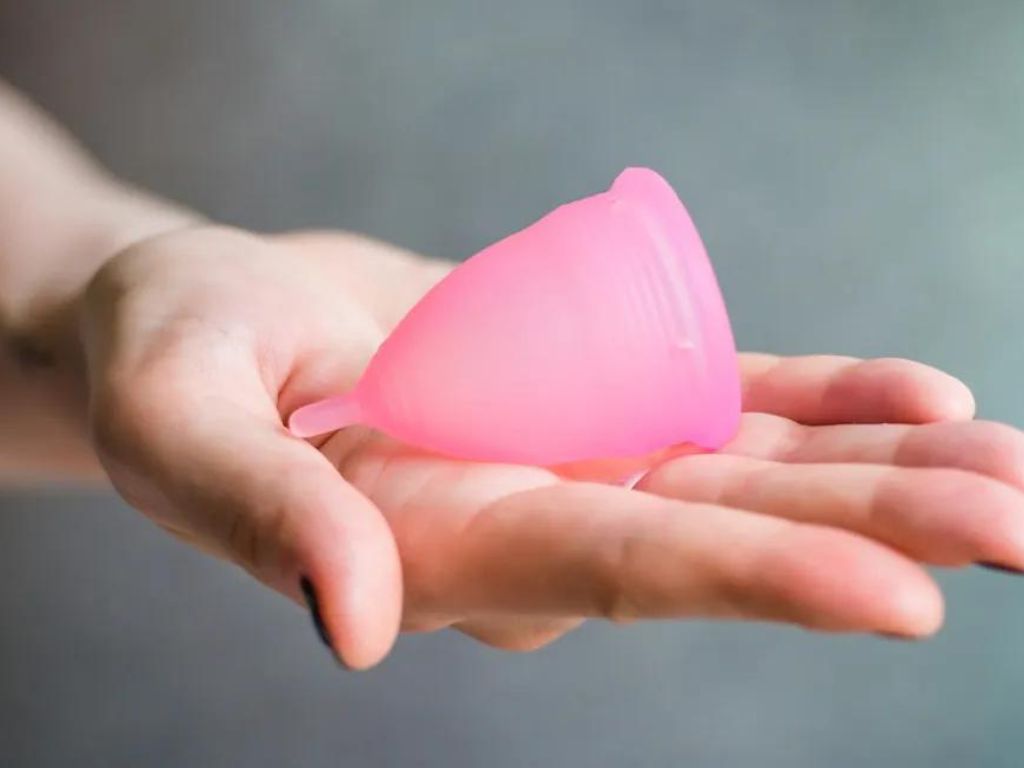
During your period, you can collect menstrual fluid using reusable menstrual cups. Although they may seem difficult initially, using a menstrual cup to collect menstrual blood is a simple, secure, affordable, and ecologically responsible method. We provide step-by-step instructions on how to use a menstrual cup safely, comfortably, and successfully, so don’t be put off by a tiny piece of silicone. Know Menstrual Cup How to Use, Remove and Maintain It
Menstrual cup: What are they?
Period cups are a type of menstrual product that is inserted into the vagina to collect menstrual fluid during your period. They are made from flexible materials such as silicone or rubber, and are designed to fit comfortably inside the vagina. To use a period cup, you simply fold it and insert it into your vagina like a tampon. The cup will then open up and create a seal against the walls of the vagina, preventing menstrual fluid from leaking out. Period cups can be worn for up to 12 hours at a time, depending on the amount of menstrual flow, and can be emptied and rinsed out as needed. They are a safe and reusable alternative to disposable menstrual products such as pads and tampons.
To begin with, you must buy one. This task could seem intimidating given the wide range of sizes and designs available for menstrual cups. Look online or at your neighbourhood drugstore to find out what possibilities are available to you. For customers with varying ages and phases of life, varied menstrual flow volumes, or different anatomical structures, many menstrual cup vendors provide various sizes. For those who have low cervixes, a shorter cup can be preferable. A more stiff cup might be more effective at stopping leaks for people who exercise more frequently.
There are many different brands of menstrual cups available, including:
These are just a few examples of the many menstrual cup brands on the market. It is important to research and compare different options to find the right one for you.
How to Use a Menstrual Cup | How do Period Cups Work
It is always a good idea to consult with your doctor before using a menstrual cup, especially if you have any underlying medical conditions or concerns. Your doctor can provide guidance on which type of cup may be best for you and can answer any questions you may have about using a menstrual cup. They can also provide advice on how to use the cup properly and address any potential concerns you may have. They may
- Your age,
- Whether or not you have a heavy flow,
- The length of your cervix,
- The cup’s hardness and flexibility,
- Its capacity,
- If you gave birth vaginally,
- Your pelvic floor muscles should be firm,
Read More -: Heavy Menstruation Bleeding | What Causes Such Heavy Periods?
Tips – Before you use Menstrual Cup
Here are a few tips to consider before using a menstrual cup:
- Make sure you read the instructions that come with your menstrual cup carefully. Different brands of menstrual cups may have slightly different instructions for use, so it is important to follow the specific instructions for your cup.
- Choose the right size of menstrual cup for your body. Most menstrual cup brands offer different sizes of cups for different body types, so it is important to choose the size that will fit you comfortably and securely.
How to insert a menstrual cup for beginners | Menstrual Cup How to Use
To insert a menstrual cup for beginners, follow these steps:
- Wash your hands thoroughly with soap and water.
- Choose a comfortable position to insert the cup, such as standing with one foot on the toilet, squatting, or sitting on the toilet with your knees apart.
- Relax your muscles and take your time. It may take a few tries to get the hang of it, so don’t be discouraged if it doesn’t work perfectly the first time.
- Fold the menstrual cup in half so that it forms a U shape or a C shape, depending on the instructions for your specific brand of cup. Hold the cup in this position with your thumb and forefinger.
- Gently insert the cup into your vagina, aiming it towards your tailbone.
- Once the cup is inside, use your finger to gently push it upwards until it is fully opened and has created a seal against the walls of your vagina. You may need to rotate the cup or run your finger around the rim to ensure it is properly positioned.
- Check for any leaks by gently pressing on the base of the cup. If you feel any leakage, try adjusting the cup by gently twisting it or running your finger around the rim.
- Empty and clean the cup according to the instructions for your specific brand of menstrual cup. It is important to keep the cup clean to prevent any infections or irritation.
It may take some practice to get the hang of inserting and removing a menstrual cup, but with time and patience, you should be able to do it comfortably and confidently.
Tips – Before you Remove Menstrual Cup
Remember to be gentle and take your time when removing your menstrual cup. If you have difficulty removing the cup, you can try bearing down or squatting to help move it lower in the vagina and make it easier to reach. If you still can’t remove it, consult with a healthcare provider for assistance.
How long you can use a menstrual cup before needing to remove it depends on the brand and size of the cup, as well as your menstrual flow. Most menstrual cups can be worn for up to 12 hours at a time, but some people may need to remove and empty their cup more frequently. It is important to follow the manufacturer’s instructions for your specific cup, and to pay attention to your body’s signals to know when to empty and reinsert the cup.
How to Remove a Menstrual Cup | How do Period Cups Work
To remove a menstrual cup, follow these steps:
- Wash your hands thoroughly with soap and water before handling the cup.
- Choose a comfortable position to remove the cup, such as standing with one foot on the toilet, squatting, or sitting on the toilet with your knees apart.
- Relax your muscles and take your time. It may take a few tries to get the hang of it, so don’t be discouraged if it doesn’t work perfectly the first time.
- Gently break the seal of the cup by squeezing the base of the cup or by running your finger around the rim of the cup.
- Gently slide the cup down and out of your vagina.
- Empty the contents of the cup into the toilet and rinse the cup with water.
- Wash the cup thoroughly with soap and water, and reinsert it according to the instructions for your specific brand of menstrual cup.
- Repeat this process as needed throughout your menstrual cycle, emptying and cleaning the cup regularly.
It is important to keep the cup clean to prevent any infections or irritation. If you have any difficulty removing the cup or if you experience any discomfort, it is best to consult with a healthcare provider for guidance.
How to Maintain a Period Cup
To maintain a menstrual cup, follow these steps:
- Empty and clean the cup regularly throughout your menstrual cycle, according to the instructions for your specific brand of menstrual cup. This typically means emptying and rinsing the cup with water after each use, and washing it thoroughly with soap and water at least once a day.
- Avoid using harsh soaps or chemicals on the cup, as these can irritate the delicate tissues of the vagina and cause discomfort or infections. Use a mild, unscented soap or a specially formulated menstrual cup wash to clean the cup.
- Store the cup in a clean, dry place when not in use. Most menstrual cups come with a storage bag or container, which can be used to keep the cup clean and free from dust or bacteria.
- Inspect the cup regularly for any signs of damage or wear. If you notice any cracks, tears, or other damage to the cup, it is important to replace it to avoid any potential health risks.
- Replace the cup according to the manufacturer’s recommendations. Most menstrual cups are designed to last for several years with proper care, but they may need to be replaced sooner if they become damaged or if you notice any changes in the way they fit or function.
By following these simple steps, you can ensure that your menstrual cup remains clean, safe, and effective throughout your menstrual cycle.
What does Period Cup cost?
The cost of menstrual cups varies depending on the brand and type of cup you choose. On average, menstrual cups can cost anywhere from $15 to $40, with some high-end cups costing even more. This is a relatively high upfront cost compared to disposable menstrual products such as pads and tampons, but menstrual cups can be used for several years with proper care, making them a cost-effective option in the long run. Additionally, some health insurance plans may cover the cost of menstrual cups, so it is worth checking with your insurer to see if you are eligible for coverage.
How to pick the appropriate feminine hygiene item for you
When choosing a feminine hygiene product, there are several factors to consider. Here are some tips to help you pick the right product for you:
- Consider your personal preferences. Different products have different benefits and drawbacks, so it is important to choose the one that works best for you. For example, some people may prefer the convenience and discretion of tampons, while others may prefer the comfort and protection of pads.
- Consider your menstrual flow. Different products are designed to accommodate different levels of menstrual flow. For example, if you have a heavy flow, you may want to choose a product with higher absorbency, such as a super-absorbent tampon or pad.
- Consider your physical activity level. If you are very active, you may want to choose a product that stays in place and doesn’t shift or leak, such as a tampon or Period cup.
- Consider your budget. Different products have different price points, so it is important to choose the one that fits your budget. Keep in mind that some products, such as menstrual cups, may have a higher upfront cost but can be used for several years, making them a cost-effective option in the long run.
- Consider the environmental impact. Disposable products such as pads and tampons can generate a lot of waste, so if you are environmentally conscious, you may want to choose a reusable product such as a menstrual cup or washable cloth pad.
Ultimately, the right product for you will depend on your personal preferences, lifestyle, and needs. It may take some trial and error to find the perfect product, but with time and patience, you can find the one that works best for you.
Frequently Asked Question –
1. A sensation of “heaviness.” After holding a full cup, your pelvic muscles feel worn out.
2. A bubbling sensation. Cups can produce a sense of bubbles about to overflow.
3. Light warning leakage.
4. A cup that moves while being held.
You can, of course. One benefit of period cups is that you don’t have to wake up in the middle of the night to change your pad or tampon.
Many individuals can’t feel their cups at all once they’ve been placed, and putting one in shouldn’t hurt (though it might take more practice to use than a tampon or pad).
Tampons and pads can’t hold as much liquid as menstrual cups. They have a reputation for keeping twice as much liquid as tampons and sanitary napkins. When there is a lot of flow, they can be helpful.
You can use a menstrual cup as soon as you start having your first period. Age is irrelevant as long as you feel comfortable using a menstrual cup. Teens should use menstrual cups since they can be more comfortable, create no waste, and are better for their bodies.




[…] Also Read – How do Period Cups Work | Know Use, Remove and Maintain It […]